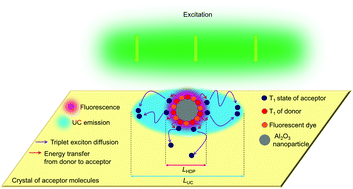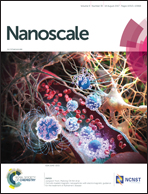Nanoscale triplet exciton diffusion via imaging of up-conversion emission from single hybrid nanoparticles in molecular crystals†
Abstract
Up-conversion materials composed of donor and acceptor molecules which convert low energy photons into higher energy ones by triplet–triplet annihilation can improve the sensitivity of photocatalysts or the efficiency of solar cells. The use of crystalline materials can lead to a decrease in the up-conversion threshold intensity due to increased diffusion length LT of triplet excitons. Here, we demonstrate direct microscopic imaging of triplet exciton diffusion in polycrystalline films. The generation of high local density of triplet states is achieved by functionalizing alumina nanospheres with donor molecules and dispersing them in the acceptor films. Diffusion of the triplet excitons and up-converted emission are reflected in enlarged microscopic images of the nanoparticles. Analysis provides the average LT values of 491 nm for the acceptor of polycrystalline anthracene and 172 nm for polycrystalline 9,10-diphenylanthracene, and reveals large distributions of the diffusion characteristics. These average values are more than an order of magnitude larger than LT obtained by a conventional method, and highlight the need for accurate nanoscale characterization of the up-conversion materials.



 Please wait while we load your content...
Please wait while we load your content...